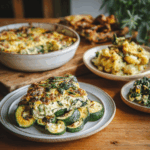Follow Me On Social Media!
Ricotta Mac and Cheese: Creamy, Cozy, and Full of Flavor
When you need a dish that feels like a warm hug, ricotta mac and cheese is it. In this article, you’ll discover how to make the creamiest version of this classic using one underrated but amazing ingredient—ricotta cheese. We’ll walk through how to balance cheeses, boost flavor, and get that baked golden top just right. You’ll also get expert answers to popular questions, along with pro tips and internal links to recipes that complement this comfort dish beautifully. Let’s dig into what makes ricotta mac and cheese your next go-to favorite.
My Story & Why Ricotta Mac and Cheese Feels Like Home
The Southern Table Meets Creamy Comfort
Growing up in Savannah, I was lucky enough to be raised on soul-warming comfort food. One of my earliest kitchen memories is standing beside my grandmother, stirring noodles while she folded cheddar into a bubbling sauce. But it wasn’t until my 30s, teaching a community cooking class, that I discovered ricotta’s potential in mac and cheese. One student added a spoonful on a whim—and the result stopped us all in our tracks. It added an unbelievable creaminess that softened the sharper cheeses without dulling the flavor. I was hooked.
Ricotta mac and cheese has been a quiet favorite at my table ever since. Whether I’m prepping it as a side for a holiday dinner or a main dish with garlic bread, it always brings comfort and compliments. If you’re looking for a twist that still honors the traditional feel of macaroni and cheese, this is it. And the best part? It’s just as simple to make as your go-to recipe, only silkier and more indulgent.
Why Ricotta Is the Secret Weapon in Mac and Cheese
Using ricotta cheese in mac and cheese adds a rich, creamy texture that no other cheese can quite replicate. While cheddar brings sharpness and mozzarella gives stretch, ricotta is what gives the dish its dreamy, melt-in-your-mouth quality. It’s also a great choice if you want a velvety texture without making a roux or dealing with flour.
Unlike some stronger cheeses, ricotta won’t overpower the dish. Instead, it balances flavors beautifully. And if you’re pairing it with other dishes like Garlic Parmesan Chicken Pasta or a crisp salad, it ties the whole meal together.
Some might wonder if ricotta is a good melting cheese. Technically, it doesn’t melt like mozzarella or Gruyère—but it blends, which is just what you want here. Combined with pasta water or milk, it becomes a luxurious sauce base that clings to every noodle. That’s why ricotta mac and cheese is especially satisfying for those who prefer a creamy bake over a runny one.
Looking to go beyond traditional flavors? You can easily pair this dish with a bright tomato salad or serve it alongside Creamy Parmesan Italian Sausage Soup for an all-out comfort spread.

Building the Best Cheese Base with Ricotta
Choosing Cheeses That Love Ricotta
Ricotta shines brightest when it plays well with others. On its own, it’s creamy and slightly sweet—but combine it with bold, melty cheeses, and it transforms into a rich, complex sauce. For a balanced blend, I always start with sharp cheddar. It delivers that nostalgic mac-and-cheese bite. Then I add mozzarella for that soft pull, and finally, ricotta for silkiness.
But don’t stop there. If you’re feeling adventurous, try tossing in a bit of grated Parmesan or fontina. These give depth and a hint of salt that wakes the whole dish up. Think of ricotta as your smoothing agent—it lets the stars shine without getting grainy or greasy.
One of my favorite dinner combos includes this dish and a slice of Chicken Parmesan. Both dishes highlight how layered cheese flavor can elevate even simple weeknight meals.
Ricotta Cheese Sauce: The Easy Way to Creaminess
Making a cheese sauce with ricotta is simpler than you’d expect. You don’t need a roux, just a gentle hand and a few key steps. After boiling your pasta, reserve half a cup of that hot starchy water—it’s magic when blended into ricotta. It helps loosen and smooth the cheese without watering it down.
In a separate bowl, whisk together ricotta, a splash of whole milk, shredded cheddar, and grated Parmesan. Stir until it’s creamy. Then fold it into your warm pasta, letting the heat melt the cheese mixture. That’s it. You now have a velvety sauce without any stove-top fuss.
If you’re going for a baked version, top it with more cheddar and a sprinkle of breadcrumbs. A 20-minute bake at 375°F gives you that golden, crispy crust. For extra flavor, I sometimes add a few dollops of Blackened Chicken Alfredo on the side.

Flavor Boosts & Add-Ins for Ricotta Mac and Cheese
Mix-Ins That Make It a Full Meal
Once you’ve nailed the base, it’s easy to make this dish more filling or flavorful with simple mix-ins. I love stirring in wilted spinach or roasted broccoli right before baking. It adds a pop of color and a little extra nutrition. For a hearty, comforting meal, crumble in some cooked Italian sausage or shredded rotisserie chicken.
Fresh herbs also go a long way. A handful of chopped basil or thyme can add depth without overpowering the dish. Craving a little spice? A dash of smoked paprika or a spoonful of chili flakes will bring gentle heat to the creamy richness.
This approach makes ricotta mac and cheese a perfect pairing for cozy dinners. For instance, serving it alongside something like Brownies with Cream Cheese Frosting creates a comforting dinner-to-dessert lineup that your guests will remember.
Seasonal Variations to Keep It Fresh
This recipe easily adapts with the seasons. In fall, stir in roasted butternut squash or caramelized onions for a slightly sweet contrast. In summer, swap elbow pasta for cavatappi and fold in cherry tomatoes and fresh corn before baking. The ricotta softens the brightness of these ingredients, making every bite taste balanced.
During winter months, I like to use heartier cheeses—like Gruyère or Asiago—for extra body and sharpness. The combination with ricotta makes the dish feel indulgent yet not too heavy. Sprinkle crushed rosemary on top before baking and serve with Pumpkin Cheesecake Cookies for a truly seasonal experience.
Want to make it even more indulgent? Add a breadcrumb topping with a bit of melted butter and bake until golden. That textural contrast between creamy noodles and a crisp top is irresistible, and it’s just the kind of detail that transforms a simple dish into something memorable.
Serving, Storing & Prepping Ricotta Mac and Cheese
Best Ways to Serve Ricotta Mac and Cheese
One of the reasons I love ricotta mac and cheese is how effortlessly it fits into any meal. Serve it as a standalone weeknight comfort dinner, or dress it up as a decadent side dish for a holiday spread. It’s amazing next to roast chicken or meatloaf, but also pairs beautifully with a bright salad tossed in lemon vinaigrette.
If you’re entertaining, this dish sits well in a warm oven or covered on the counter for up to an hour. Right before serving, you can sprinkle on a bit more cheese or add a few twists of black pepper to wake up the flavor.
For a Southern-style twist, serve it with Sweet Potato Muffins or Cheesecake Cookies. These combinations turn a simple evening into a soulful, satisfying experience.
How to Store, Reheat & Prep Ahead
Ricotta mac and cheese is a meal-prepper’s dream. You can assemble the whole dish up to 2 days in advance—just keep it covered in the fridge and bake it when ready. Add an extra splash of milk before baking to keep the texture creamy.
Leftovers store beautifully in an airtight container for up to 4 days. Reheat gently in the microwave with a spoonful of milk or cream stirred in halfway through to revive that silky texture.
Freezing? Absolutely. Portion it into individual containers or freeze the whole pan unbaked. Just thaw overnight in the fridge before baking. It’s a lifesaver for busy weeks or hosting on short notice.
Frequently Asked Questions :
Is ricotta cheese good in mac and cheese?
Yes! Ricotta adds an ultra-creamy texture without overpowering the dish. It blends beautifully with sharper cheeses like cheddar and enhances the sauce’s smoothness.
Is ricotta a good melting cheese?
Technically, ricotta doesn’t melt like mozzarella or Gruyère. Instead, it softens and blends, creating a creamy base that clings to pasta without breaking or becoming greasy.
Which cheese is best for mac and cheese?
Sharp cheddar is classic for flavor. Add mozzarella for stretch and ricotta for creaminess. Parmesan or Gruyère can add depth and complexity if desired.
What does ricotta cheese pair well with?
Ricotta pairs well with roasted vegetables, fresh herbs, tomato-based sauces, and proteins like sausage or chicken. It’s also a great match for baked pastas, toasts, or stuffed shells.
Conclusion:
If you’re craving a dish that’s creamy, cheesy, and undeniably comforting, ricotta mac and cheese is exactly what your table needs. With its silky texture and balanced flavor, ricotta mac and cheese transforms a familiar favorite into something truly special. The magic of ricotta mac and cheese lies in how easily it comes together, yet tastes like you spent hours in the kitchen.
Whether you bake it for Sunday dinner, prep it for the week ahead, or serve it beside roasted chicken, ricotta mac and cheese always delivers. Add it to your recipe rotation and watch it become a go-to for cozy nights and crowd-pleasing gatherings alike. Once you try ricotta mac and cheese, you won’t go back.





